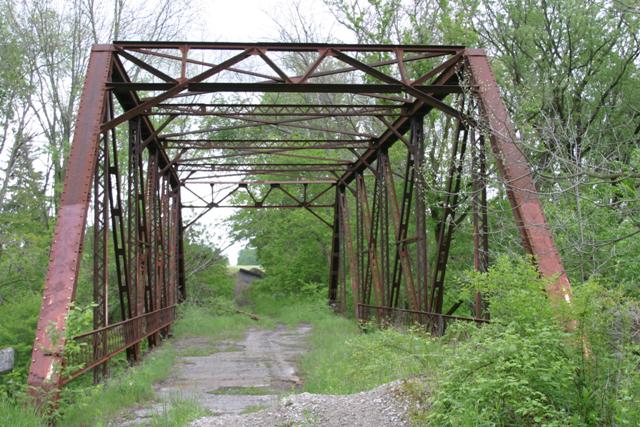We Recommend:
Bach Steel - Experts at historic truss bridge restoration.
BridgeHunter.com Phase 1 is released to the public! - Visit Now
CR-242 Bridge
Old OH-42 Bridge

Primary Photographer(s): Nathan Holth and Rick McOmber
Bridge Documented: May 19, 2006 and August 11, 2012
Not Available or Not Applicable
Not Available
89.0 Feet (27.1 Meters)
Not Available
1 Main Span(s)
59XXXX1

View Information About HSR Ratings
Bridge Documentation
This attractive through truss is buried away on an abandoned road. This road used to be the old alignment of US-42 The portal bracing for this bridge is rather unusual in design. There is v-lacing on the verticals and some diagonals, as well as one the sway bracing. Lattice railings remain on the bridge. There are unusual concrete railings leading up to this bridge. "COHAINS GIRKINS" presumably a contractor and "1924" is a date cast into these unusual concrete railings, which many have assumed is construction date for the truss bridge as well. However, a close examination of this bridge led to several questions that may indicate the bridge is older than 1924. First, the bridge has built-up vertical members composed of two pairs of angles with v-lacing. This is fairly lightweight, especially for a 1924 bridge. More common are built-up verticals with back-to-back channels and v-lacing on each side. The most unusual aspect however is found in the struts and overhead lateral bracing. Facing northeast, an unusual splice occurs toward the left end of the struts. The lateral bracing also is spliced. Typically, long members on a truss, such as the top chord, were frequently spliced together in the field since they had to be shipped in lengths that were manageable. However, the struts are not long enough to justify needing to be shipped in two segments, especially considering that the splice only allow for a short amount of additional length. Also, at the splice point, the pattern of v-lacing is interrupted by a batten. There is no reason for this batten to be here, and the only other place that battens are present are at the ends of the struts. This batten next to the splice also makes the strut asymmetrical in appearance, which is not normal. Long story short, the current appearance of the struts suggest that this bridge was widened. The widening likely occurred in 1924, since a wider bridge would need new or expanded abutments. It may have anticipated the road and bridge serving US-42, which may have increased traffic on the road, making having a wider bridge prudent. Assuming this theory is accurate, the original bridge may date to ca 1910-1915.
Information and Findings From Ohio's Historic Bridge InventorySetting/Context The bridge is closed to traffic and located on an abandoned section of county road (former US 42). Physical Description The 1 span, 89'-long, rivet-connected Pratt thru truss bridge is traditionally composed of built-up members. Summary of Significance The 1924 Pratt thru truss is a late example of its type/design with no distinguishing features. It has riveted connections, typical of Pratt trusses from about 1900 to the 1940s when riveted connections began to
be phased out in favor of welded connections. This example is not historically significant for its technology or context. More distinguished examples better represent the significance of the type/design in the development of the
state's road systems. Bridge Considered Historic By Survey: No |
![]()
Photo Galleries and Videos: CR-242 Bridge
2012 Bridge Photo-Documentation
Original / Full Size PhotosA collection of overview and detail photos, taken August 11, 2012. This gallery offers photos in the highest available resolution and file size in a touch-friendly popup viewer.
Alternatively, Browse Without Using Viewer
![]()
2012 Bridge Photo-Documentation
Mobile Optimized PhotosA collection of overview and detail photos, taken August 11, 2012. This gallery features data-friendly, fast-loading photos in a touch-friendly popup viewer.
Alternatively, Browse Without Using Viewer
![]()
2006 Bridge Photo-Documentation
A collection of overview and detail photos, taken May 19, 2006. This photo gallery contains a combination of Original Size photos and Mobile Optimized photos in a touch-friendly popup viewer.Alternatively, Browse Without Using Viewer
![]()
Maps and Links: CR-242 Bridge
Coordinates (Latitude, Longitude):
Search For Additional Bridge Listings:
Bridgehunter.com: View listed bridges within 0.5 miles (0.8 kilometers) of this bridge.
Bridgehunter.com: View listed bridges within 10 miles (16 kilometers) of this bridge.
Additional Maps:
Google Streetview (If Available)
GeoHack (Additional Links and Coordinates)
Apple Maps (Via DuckDuckGo Search)
Apple Maps (Apple devices only)
Android: Open Location In Your Map or GPS App
Flickr Gallery (Find Nearby Photos)
Wikimedia Commons (Find Nearby Photos)
Directions Via Sygic For Android
Directions Via Sygic For iOS and Android Dolphin Browser
USGS National Map (United States Only)
Historical USGS Topo Maps (United States Only)
Historic Aerials (United States Only)
CalTopo Maps (United States Only)


